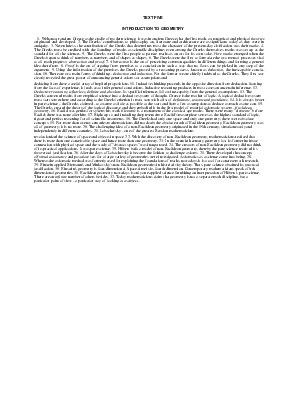
TEXT FIVE
INTRODUCTION TO GEOMETRY
1. We honour ancient Greece as the cradle of modern science; it was in ancient Greece that the first math, astronomical and physical theories originated and developed. 2. The Greeks' contributions to philosophy, art, literature and architecture are as significant today as they were in antiquity. 3. Nevertheless, the contribution of the Greeks that determines most the character of the present-day civilization was their maths. 4. The Greeks must be credited with the founding of maths as scientific discipline; even among the Greeks themselves maths was set up as the standard for all the sciences. 5. The Greeks were the first people to pursue maths as an art for its own sake. Pure maths emerged when the Greeks began to think of numbers as numbers and of shapes as shapes. 6. The Greeks were the first to formulate the two mental processes vital to all math progress: abstraction and proof. 7. Abstraction is the art of perceiving common qualities in different things and forming a general idea therefrom. 8. Proof is the art of arguing from premises to a conclusion in such a way that no flaws can be picked in any step of the argument. 9. Using the information of the premises the Greeks proved by a reasoning process, known as deduction, the inescapable conclusion. 10. There are two main forms of thinking - deduction and induction. For the former we are chiefly indebted to the Greeks. They first saw clearly revealed the great power of announcing general axioms or assumptions and
deducing from these a useful array of implied propositions. 11. Inductive thinking proceeds in the opposite direction from deduction. Starting from the facts of experience, it leads us to infer general conclusions. Inductive reasoning produces in most cases an uncertain inference. 12. Deductive reasoning is flawless, definite and absolute. Its specific inferences follow inescapably from the general assumptions. 13. The Greeks converted maths from empirical science into a deductive system of thought. Greece is the mother of logic. A logical deductive system must start somewhere and according to the Greeks' criterion it must start with a list of definitions, axioms and postulates. 14. It is always better in pure science - the Greeks claimed - to assume as little as possible at the start and from a few assumptions to deduce as much as one can. 15. The Greeks created the theory of the logical discourse and they embodied it in the first model of material axiomatic system - Euclidean geometry. 16. Euclid was genius for system; his work Elements is a monument of the classical age maths. There were many "elements" before Euclid; there was none after him. 17. Right up to and including the present time, Euclid's masterpiece serves as the highest standard of logic, rigour and perfect reasoning for all scientific treatments. 18. The Greeks had only one space and only one geometry; these were absolute concepts. 19. For more than twenty centuries mathematicians did not doubt the absolute truth of Euclidean geometry. Euclidean geometry was all of geometry; it is no more. 20. The challenging idea of a non-Euclidean geometry originated in the 19th century, simultaneously and independently in different countries. 21. Lobachevsky - one of the greatest Russian mathematicians
revolutionized the science of space and objects in space. 22. With the discovery of non-Euclidean geometry, mathematicians realized that there is more than one conceivable space and hence more than one geometry. 23. In the twentieth century geometry lost its former intimate connection with physical space and the study of "abstract spaces" was inaugurated. 24. The creators of non-Euclidean geometry did not think of its practical applications. It was pure science. 25. Hilbert built a model of non-Euclidean geometry, thereby the pure science received its theoretical justification. 26. After the days of Lobachevsky it became the fashion to challenge axioms. 21. There developed the concept offormal axiomatics and postulate sets for a large variety of geometries were investigated. Axiomatics as a science came into being. 28. Whereas the axiomatic method was formerly used for explaining the foundations of maths, nowadays it is a tool for concrete math research. 29. Einstein applied Riemann's and Minkovsky's non-Euclidean geometries in his relativity theory. Thus, pure science obtained its practical justification. 30. Einstein's geometry is four-dimensional. Space-time is its fourth dimension. Contemporary mathematicians speak of /rth dimensional geometries. 31. Euclidean geometry nowadays is only one applied science furnishing an interpretation of Hilbert's pure science. There are an infinite number of others besides. 32. Today mathematicians claim that geometry is not a separate math discipline, but a particular point of view - a particular way of looking at a subject..
Уважаемый посетитель!
Чтобы распечатать файл, скачайте его (в формате Word).
Ссылка на скачивание - внизу страницы.